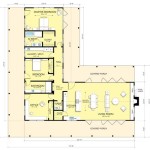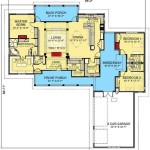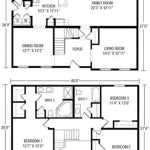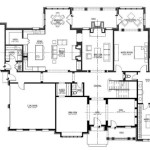Small open house plans are blueprints for compact dwellings that emphasize a seamless flow of space. They prioritize efficient use of square footage by incorporating open-concept layouts, where traditional walls separating rooms are eliminated or minimized. This design strategy creates a sense of spaciousness and promotes a cohesive living environment.
For instance, a small open house plan might feature a combination living room, dining room, and kitchen, all seamlessly connected. This eliminates the need for distinct rooms while fostering a sense of togetherness and encouraging interaction among family members or guests.
In this article, we will delve into the intricacies of small open house plans, exploring their advantages, design considerations, and practical applications. Whether you’re embarking on a new home construction project or seeking inspiration for space-saving solutions, this comprehensive guide will provide valuable insights into the world of small open house plans.
Small open house plans offer several key advantages, making them a popular choice for homeowners seeking space-efficient and modern living solutions:
- Maximize space
- Enhance natural light
- Foster communication
- Accommodate diverse needs
- Promote flexibility
- Reduce construction costs
- Simplify maintenance
- Create a sense of flow
- Improve accessibility
- Increase resale value
These plans prioritize functionality and adaptability, ensuring that every square foot is utilized efficiently without compromising comfort or style.
Maximize space
Small open house plans excel at maximizing space through their efficient use of square footage. By eliminating or minimizing walls, these plans create a sense of spaciousness even in compact dwellings. Open-concept layouts allow for multiple functions to be accommodated within a single room, reducing the need for dedicated spaces.
For instance, a small open house plan might incorporate a combined living room, dining room, and kitchen. This eliminates the need for separate rooms for each function, freeing up valuable square footage. Additionally, open floor plans promote a sense of flow and connectivity, making the space feel larger than its actual dimensions.
Furthermore, small open house plans often utilize vertical space effectively. Lofts, mezzanines, and built-in storage solutions are commonly employed to create additional living areas or storage space without increasing the footprint of the home.
Overall, small open house plans prioritize space-saving strategies, ensuring that every square foot is utilized efficiently without compromising comfort or functionality.
Enhance natural light
Small open house plans are designed to maximize natural light, creating a brighter and more inviting living environment. Here are some key strategies employed in these plans to enhance natural light:
- Large windows and glass doors: Small open house plans often feature large windows and glass doors that allow ample natural light to flood the interior spaces. These expansive glazed areas not only provide stunning views of the outdoors but also reduce the need for artificial lighting during the day.
- Open floor plans: Open floor plans eliminate or minimize walls between rooms, allowing natural light to penetrate deeper into the home. This interconnected layout ensures that even interior spaces receive adequate daylight.
- Skylights and solar tubes: Skylights and solar tubes are strategically placed to bring natural light into areas that may not have direct access to windows. These architectural features allow sunlight to enter from above, illuminating interior spaces and reducing the reliance on artificial lighting.
- Light-colored interiors: Small open house plans often utilize light-colored interiors, such as white or beige walls and ceilings. These light colors reflect natural light, making the space feel brighter and more airy.
By incorporating these strategies, small open house plans create a well-lit and inviting living environment that takes advantage of natural light to reduce energy consumption and enhance overall well-being.
Foster communication
Small open house plans are designed to foster communication and interaction among family members and guests. Here’s how these plans promote effective communication:
Open sightlines: Open floor plans eliminate visual barriers between different areas of the home, creating open sightlines. This allows family members to maintain visual contact and interact with each other even when they are engaged in different activities. For instance, a parent cooking in the kitchen can easily keep an eye on children playing in the living room, facilitating informal conversations and strengthening family bonds.
Central gathering spaces: Small open house plans often incorporate central gathering spaces, such as a large living room or dining area. These spaces serve as hubs for communication and interaction, encouraging family members to come together and engage in conversations, games, or shared activities. By providing a dedicated space for socializing, open house plans promote a sense of community and togetherness.
Reduced noise levels: Open floor plans, when combined with sound-absorbing materials, can help reduce noise levels throughout the home. This creates a more conducive environment for communication, as family members can easily hear and understand each other without having to raise their voices. Reduced noise pollution fosters a sense of calm and tranquility, facilitating meaningful conversations and promoting relaxation.
Multi-functional spaces: Small open house plans often feature multi-functional spaces that can accommodate various activities. For instance, a kitchen island might serve as a food preparation area, a casual dining spot, and a homework station. These multi-purpose spaces encourage family members to interact with each other while pursuing different activities, fostering a sense of shared experience and connection.
Overall, small open house plans are designed to create a living environment that encourages communication, interaction, and a sense of community among family members and guests.
Accommodate diverse needs
Small open house plans are designed to accommodate the diverse needs of families and individuals, providing flexible and adaptable living spaces that can evolve as needs change over time. Here’s how these plans address a range of diverse needs:
- Multi-generational living: Small open house plans can be easily adapted to accommodate multi-generational living arrangements. By incorporating flexible spaces that can serve multiple functions, these plans allow families to create separate living quarters for elderly parents or adult children while maintaining a sense of togetherness and shared space.
- Changing family dynamics: Small open house plans can adapt to changing family dynamics, such as growing children or the addition of new family members. Flexible floor plans allow for easy reconfiguration of spaces to accommodate different needs, such as adding a bedroom or expanding a living area.
- Accessibility features: Small open house plans can be designed to incorporate accessibility features for individuals with disabilities or mobility impairments. Wider doorways, ramps, and accessible bathrooms ensure that all family members can move around the home safely and comfortably.
- Home offices and workspaces: With the increasing demand for home-based work, small open house plans can be adapted to create dedicated home offices or workspaces. Multi-functional spaces, such as a spare bedroom or a loft, can be easily converted into productive work environments without compromising the overall flow of the home.
Overall, small open house plans provide flexible and adaptable living spaces that can accommodate the diverse needs of families and individuals, ensuring that the home remains a comfortable and functional space for all.
Promote flexibility
Small open house plans prioritize flexibility, allowing homeowners to adapt their living spaces to changing needs and preferences. Here’s how these plans achieve flexibility:
- Reconfigurable layouts: Open floor plans, combined with movable furniture and modular elements, allow for easy reconfiguration of spaces. Walls can be added or removed, and furniture can be rearranged to create different room configurations, adapting the home to evolving needs over time.
- Multi-purpose spaces: Small open house plans incorporate multi-purpose spaces that can accommodate various functions. For instance, a loft can serve as a guest room, a home office, or a play area, depending on the current needs of the family.
- Expandable designs: Some small open house plans are designed with the potential for future expansion. This flexibility allows homeowners to add on additional rooms or enlarge existing spaces as their family grows or their needs change.
- Built-in storage solutions: Ample and well-planned storage solutions, such as built-in shelves, cabinets, and drawers, help maintain a clutter-free and organized living environment. These storage solutions can be customized to accommodate changing storage needs, ensuring that the home remains functional and adaptable.
By incorporating these flexibility-promoting features, small open house plans empower homeowners to create living spaces that can adapt and evolve alongside their changing needs and lifestyles.
Reduce construction costs
Small open house plans are designed to minimize construction costs without compromising on quality or functionality. Here are several key strategies employed in these plans to reduce construction expenses:
Efficient use of materials: Open floor plans eliminate the need for excessive walls and partitions, reducing the amount of materials required for construction. This efficient use of materials translates into significant cost savings, particularly in regions where building materials are expensive.
Simplified structural systems: Small open house plans often utilize simplified structural systems, such as open-web floor joists and trusses. These systems require less lumber and labor to install, further reducing construction costs compared to traditional framing methods.
Reduced labor costs: The streamlined design of small open house plans minimizes the need for complex construction techniques and specialized labor. This reduction in labor requirements contributes to lower overall construction costs.
Energy-efficient features: Small open house plans often incorporate energy-efficient features, such as high-performance windows and insulation. These features not only reduce energy consumption and operating costs but also qualify for tax credits and rebates in many regions, further reducing the overall construction costs.
Prefabricated components: Some small open house plans utilize prefabricated components, such as pre-assembled wall panels and roof trusses. These components are manufactured off-site and assembled on-site, reducing construction time and labor costs.
By incorporating these cost-saving strategies, small open house plans offer homeowners an affordable option to build a comfortable and functional home without breaking the bank.
Simplify maintenance
Small open house plans are designed to simplify maintenance and upkeep, making them ideal for busy families and individuals who value their time and resources. Here are several key ways in which these plans achieve maintenance simplicity:
Reduced surface area: Open floor plans eliminate unnecessary walls and partitions, resulting in a reduced overall surface area that requires cleaning and maintenance. This reduction in surface area not only saves time and effort but also minimizes the need for cleaning supplies and materials.
Easy-to-clean surfaces: Small open house plans often incorporate easy-to-clean surfaces, such as hardwood floors, tile, and quartz countertops. These surfaces resist stains and dirt, making them easy to maintain and keep looking their best with minimal effort.
Minimalistic design: The minimalistic design of small open house plans eliminates unnecessary clutter and decorative elements that can accumulate dust and require frequent cleaning. This streamlined approach to design contributes to a cleaner and more manageable living environment.
Energy-efficient appliances: Small open house plans often incorporate energy-efficient appliances, such as refrigerators, dishwashers, and washing machines. These appliances not only reduce energy consumption and utility bills but also require less frequent maintenance and repairs, further simplifying home upkeep.
Overall, the simplified maintenance features of small open house plans provide homeowners with a low-maintenance living environment, allowing them to spend less time on chores and more time enjoying their homes and pursuing their passions.
Create a sense of flow
Small open house plans are designed to create a sense of flow and continuity throughout the living space. Here are several key strategies employed in these plans to achieve this:
Open floor plans: Open floor plans eliminate or minimize walls between different areas of the home, creating a seamless flow of space. This interconnected layout allows for easy movement and interaction between different zones, fostering a sense of togetherness and community.
Wide hallways and doorways: Small open house plans often incorporate wide hallways and doorways to facilitate smooth transitions between rooms. Theseallow for easy flow of traffic, reducing congestion and creating a more spacious feel.
Visual connections: Open floor plans promote visual connections between different areas of the home. Large windows and glass partitions allow for natural light to penetrate deep into the interior, creating a sense of openness and continuity. Additionally, sightlines are carefully considered to ensure that different spaces maintain visual engagement, fostering a sense of connection and flow.
Consistent flooring: Utilizing the same flooring material throughout the main living areas of a small open house plan helps create a cohesive and seamless flow. This continuity of flooring eliminates visual barriers and enhances the sense of spaciousness, making the home feel larger and more connected.
Overall, the thoughtful integration of these design elements in small open house plans creates a sense of flow and continuity, enhancing the overall livability and enjoyment of the home.
Improve accessibility
Small open house plans prioritize accessibility to ensure that all individuals, regardless of their age or physical abilities, can comfortably navigate and enjoy the living space. Here are several key strategies employed in these plans to enhance accessibility:
Wide doorways and hallways: Small open house plans incorporate wide doorways and hallways to accommodate wheelchairs, walkers, and other mobility aids. These wider pathways ensure that individuals can move around the home safely and independently.
Step-free entry: Many small open house plans feature step-free entry, eliminating potential barriers for individuals with mobility impairments. Ramps or gradual slopes are often used to provide easy access to the home from the exterior.
Accessible bathrooms: Bathrooms in small open house plans are designed to be accessible, featuring wider doorways, roll-in showers, and grab bars. These modifications allow individuals with mobility limitations to use the bathroom safely and comfortably.
Universal design principles: Small open house plans often adhere to universal design principles, which aim to create spaces that are accessible and usable by people of all abilities. This includes features such as lever handles, adjustable countertops, and accessible light switches, making the home more comfortable and convenient for everyone.
Overall, the incorporation of these accessibility features in small open house plans ensures that the home is both welcoming and functional for individuals with diverse needs, promoting inclusivity and independence.
Increase resale value
Small open house plans can significantly increase the resale value of a home by appealing to a wider range of potential buyers. Here are several key reasons why:
Growing demand for open floor plans: Open floor plans have become increasingly popular in recent years, as they offer a sense of spaciousness, flexibility, and modern living. Small open house plans cater to this growing demand, making them highly desirable among potential buyers.
Adaptability to changing needs: Small open house plans are highly adaptable, allowing homeowners to easily reconfigure the space to meet their changing needs. This adaptability is particularly appealing to families with growing children or individuals who anticipate future changes in their lifestyle. Potential buyers recognize the value of a home that can evolve alongside their needs.
Enhanced accessibility: As discussed earlier, small open house plans prioritize accessibility features, such as wide doorways, step-free entry, and accessible bathrooms. These features not only make the home more comfortable and convenient for current occupants but also increase its appeal to potential buyers who may have mobility limitations or plan for future accessibility needs.
Energy efficiency and sustainability: Small open house plans often incorporate energy-efficient features, such as high-performance windows, insulation, and energy-efficient appliances. These features not only reduce energy consumption and operating costs but also align with the growing demand for sustainable and environmentally friendly homes. Potential buyers are increasingly seeking homes that minimize their environmental impact and utility expenses.
Overall, the combination of desirable features, adaptability, accessibility, and sustainability makes small open house plans highly sought-after by potential buyers, ultimately increasing the resale value of the home.










Related Posts








